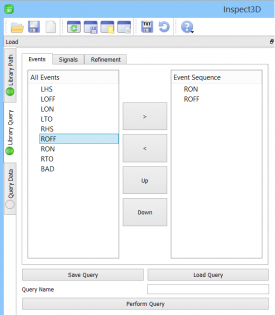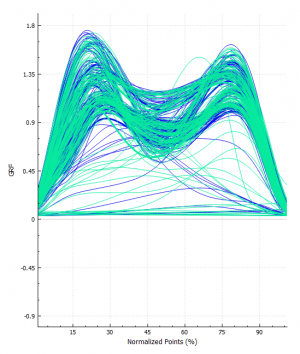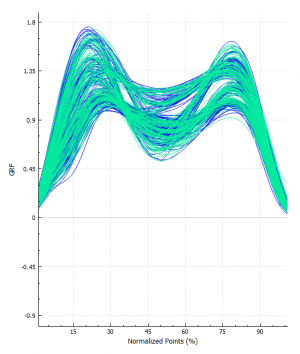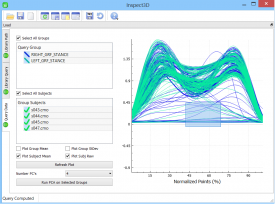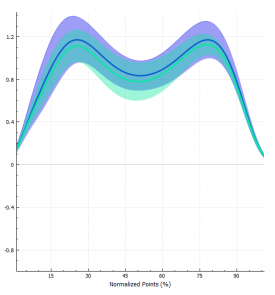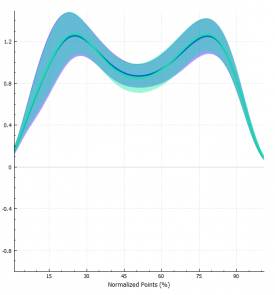Inspect3D Overview: Difference between revisions
No edit summary |
No edit summary |
||
| Line 52: | Line 52: | ||
<span style="font-size:150%"> | <!--<span style="font-size:150%"> | ||
<span style="font-family:Garamond;"> | <span style="font-family:Garamond;"> | ||
<span style="color:darkblue">Inspect3D and the Visual3D CMO Library.</span> | <span style="color:darkblue">Inspect3D and the Visual3D CMO Library.</span> | ||
</span> | </span> | ||
</span> | </span>--> | ||
=Inspect3D and the Visual3D CMO Library= | |||
The Inspect3D program accesses [[CMO_Library|Visual3D's CMO library]] directly, and is thus ideal for exploring large amounts of data from the library. Visual3D tends to be a "session based" analysis tool, and is used to process data from one (or a few) data collection sessions, rather than a project based tool. Inspect3D was created to bridge the gap between the biomechanical analysis of the Motion Capture data collected from a single subject to the scientific enterprise of trying to make sense of data from a group or population. | The Inspect3D program accesses [[CMO_Library|Visual3D's CMO library]] directly, and is thus ideal for exploring large amounts of data from the library. Visual3D tends to be a "session based" analysis tool, and is used to process data from one (or a few) data collection sessions, rather than a project based tool. Inspect3D was created to bridge the gap between the biomechanical analysis of the Motion Capture data collected from a single subject to the scientific enterprise of trying to make sense of data from a group or population. | ||
Revision as of 20:36, 28 April 2022
| Language: | English • français • italiano • português • español |
|---|
Inspect3D. Analytics and Data Exploration for Biomechanics.
Classify. Analyze. Reduce. Explore
The Quality of your Data matters. 3D Motion Capture is an incredibly powerful tool for recording the motion of markers attached to a subject. Anyone that records and analyzes 3D MoCap data for a living recognizes the subtle challenges of getting a good representation of the position and orientation of the skeleton of a subject in a repeatable and reliable way. As Murphy's law states, Anything that can go wrong, will go wrong.
Investigators must be tremendously diligent about the integrity of their data by developing principled processes for data collection and analyses, but artifacts do "slip in". Inspect3D is a tool that allows you to explore your Visual3D library of motion capture data (cmo files) to ensure that the signals that are used in your interpretation of the data or statistical analyses are as free from artifacts as possible.
Inspect3D then takes care of the bookkeeping required to keep track of the data in a supervised way, allowing you to return quickly to the original data files, and to allow systematic querying of all of your library for isolating the groups of signals that will be used for your analyses. By simply storing your query, you can return to your analyses at a future time (e.g. when the reviewer's have critiqued your article), or you can access the work of a colleague or trainee directly from your own desk.
Inspect3D provides a powerful tool for those who CARE about their data; Reduce the data to signals that are free from artifact or errors; Explore your data efficiently; Classify and Analyze your data statistically; or export the data to third party statistical analysis tools.
|
Inspect3D and the Visual3D CMO Library
The Inspect3D program accesses Visual3D's CMO library directly, and is thus ideal for exploring large amounts of data from the library. Visual3D tends to be a "session based" analysis tool, and is used to process data from one (or a few) data collection sessions, rather than a project based tool. Inspect3D was created to bridge the gap between the biomechanical analysis of the Motion Capture data collected from a single subject to the scientific enterprise of trying to make sense of data from a group or population.
| The CMO Library (more...) | ||
|---|---|---|
|
|
Structured Queries of the Visual3D CMO Library.
Permits the user to query the library by group (Visual3D Tag), signal (Joint Angle), temporal range (Heel Strike to Heel Strike), plus a variety of metric values (age, height). The flexibility to mix and match or to sequentially refine a query allows deep exploration of the data.
| Structured Queries (more....) | ||
|---|---|---|
|
Exporting Data from the Visual3D CMO Library.
Many of our customers currently export data from Visual3D to be used in Statistics programs. The problem with this approach is that the elaborate "model definitions, signal definitions, signal history" properties of the signals that is generated by Visual3D and stored in the cmo library, gets lost. This forces the user to derive their own bookkeeping strategies for their data, which at best are a replication of the cmo library, and at worst are completely lost. Inspect3D allows you to preserve the rich legacy of the data, while still getting data files formatted for your favorite statistical package.
| Exporting Data (more...) | ||
|---|---|---|
|
Inspect3D as a Quality Assurance Tool.
During the development of Inspect3D we discovered that it was incredibly useful for exploring data quickly, and its role in "Quality Assurance" dominated our early use of the tool. Many research studies involve data collected by multiple investigators from multiple labs - differences that are liable to lead to artifact. The Quality Assurance function of Inspect3D is particularly helpful for lab managers (or supervisors of students) who may not be familiar with the raw data, or for collaborators that were not involved in the data collection process. For instance, Inspect3D allows the user to check the force assignments of all their files at once, and then easily correct any artifacts that are found.
 Thanks to [XKCD.com]
Thanks to [XKCD.com]
Most, if not all, Motion Capture data contains artifact of some sort, and it is a nuisance, at best, and a catastrophe, at worst, if these affect the statistical analysis, and consequent interpretation of data. Inspect3D's ability to provide a straightforward way to examine all data used in any statistical analysis has generated considerable interest with academic and industrial researchers, during many discussions we have held at various conferences and lab visits, all over the world, this year.
These two figures contain data from the same cmo library. Several of the signals in the left figure were artifacts that were removed from the analysis by Inspect3D. Each signal can be traced back to its source data file to verify that there was something wrong, or that the problem was correctable (e.g. Motion Capture markers may have been mislabeled). Clearly stats performed on the left graph will be different that the same stats on the right graph.
Inspect3D takes a necessary chore that may take hours using other software into a streamlined process that takes minutes to perform.
| Data Quality Assurance (more....) | ||||||||
|---|---|---|---|---|---|---|---|---|
|
If an errant signal is found in these other packages, it can be both difficult and time consuming to trace the issue back to a cmo file and individual trial. Inspect3D is tightly coupled with the cmo library.
|
Biomechanical Waveform Data.
Many biomechanical signals (eg. joint angles or joint moments) are represented by a time series of data and should be compared statistically as time series.
| Zero dimensional analyses of one dimensional signals (more....) |
|---|
|
|
Each of the signals in the figure is time normalized to 101 points (common in most gait studies), resulting in more than 10,000 data points in this figure. In the figure there is data from two groups of subjects. Identifying differences between groups (typically an important statistical goal) is challenging because of the substantial variability within each group. The challenge is to identify the most salient features of the data that discriminate the two groups without removing important information.
Principal Component Analysis.
The original intention of Inspect3D was actually to perform waveform based Principal Component Analysis (PCA). PCA was developed in Collaboration with Dr. Kevin Deluzio at Queen's University, and follows the explanation of the analysis described in Research methods in Biomechanics.
| Principal Component Analysis (more....) | ||
|---|---|---|
|
For a step-by-step example of how to use Inspect3D PCA see our Principal Components Analysis Tutorial.
|





